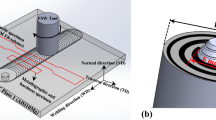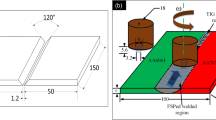Abstract
In the present study, a new-developed method which leads to the determination of the number of beads in the single-V butt weld joint, is introduced and applied to robotic Flux-cored arc welding technique. The correlation between the wire feed rate, the wire variables, the torch welding speed, and the bead reinforcement area is investigated and determined via a mathematical formula. The investigation includes a theoretical section where the method is analyzed and several confirmation experiments where the theoretical function of the bead reinforcement area is verified. Moreover, the method is applied to a multipass weld of steel plates with preselected welding parameters, through the determination of a proposed weld profile based on the fundamental principles, standards, and rules of the welding technology. The methodology can be also expanded in the case of multipass welding joints with a different edge preparation such as J, U, or double-V in butt and tee weld joints.
Similar content being viewed by others
References
Lv N, Xu Y, Fang G, Zhao H, Chen S (2015) Mechanism analysis and feature extraction of arc sound channel for pulse GTAW welding dynamic process. In: Tarn T, Chen S, Chen X (eds) Robotic welding, intelligence and automation: RWIA’2014. Springer International Publishing, Cham, pp 249–261
Chen SB, Lv N (2014) Research evolution on intelligentized technologies for arc welding process. J Manuf Process 16(1):109–122
Palani PK, Murugan N (2006) Sensitivity analysis for process parameters in cladding of stainless steel by flux cored arc welding. J Manuf Process 8(2):90–100
Senthilkumar B, Kannan T (2013) Sensitivity analysis of flux cored arc welding process variables in super duplex stainless steel claddings. Procedia Eng 64:1030–1039
Weglowski MS, Huang Y, Zhang Y (2008) Relationship between wire feed speed and metal transfer in GMAW. J Achiev Mater Manufacturing Eng 29(2):191–194
Rao ZH, Zhou J, Tsai HL (2012) Determination of equilibrium wire-feed-speeds for stable gas metal arc welding. Int J Heat Mass Transf 55, 23–24:6651–6664
ASM International (1993) ASM handbook volume 6: welding, brazing, and soldering
The Lincoln Electric Company (2010) Gas metal arc welding. Product and procedure selection
Ramos-Jaime D, Lopez-Juarez I, Perez P (2013) Effect of process parameters on robotic GMAW bead area estimation. Procedia Technol 7:398–405
Nouri M, Abdollah-zadeh A, Malek F (2007) Effect of welding parameters on dilution and weld bead geometry in cladding. J Mater Sci Technol 23(06):817
Tewari SP, Gupta A, Prakash J (2010) Effect of welding parameters on the weldability of material. Int J Eng Sci Technol 2(4):512–516
Hunt AC, Kluken AO, Edwards GR (1994) Heat input and dilution effects in microalloyed steel weld metals. Weld J 73:9–15
Mostafa NB, Khajavi MN (2006) Optimisation of welding parameters for weld penetration in FCAW. J Achiev Mater Manufactruring Eng 16:13–17
Kannan T, Yoganandh J (2010) Effect of process parameters on clad bead geometry and its shape relationships of stainless steel claddings deposited by GMAW. Int J Adv Manuf Technol 47:1083–1095
Kumar VV, Murugan N (2011) Effect of FCAW process parameters on weld bead geometry in stainless. J Miner Mater Charact Eng 10:827–842
BS EN ISO (2009) BS EN 1011-1:2009, Welding. Recommendations for welding of metallic materials. General guidance for arc welding
Pirinen M (2013) The effects of welding heat input on the usability of high strength. PhD Thesis, Lappeenranta University of Technology
Konda N, et al. (2003) Development of structural steel with superior resistance against fatigue crack growth, 22nd International Conference on Offshore Mechanics and Arctic Engineering, 110
Pires JN, Loureiro A, Bolmsjo G (2006) Welding robots: technology, system issues and applications. Springer, London
Palani PK, Murugan N (2007) Modeling and simulation of wire feed rate for steady current and pulsed current gas metal arc welding using 317L flux cored wire. Int J Adv Manuf Technol 34:1111–1119
Sreeraj P, Kannan T, Subhashs M (2013) Prediction and optimization of weld bead geometry in gas metal arc welding process using RSM and fmincon. J Mech Eng Res 5:145–153
Wahab MS, Tham AG, Abas S, Mohd N, Abd B (2015). The correlation of consumable wire feed rate with welding current in GMAW Process, 2nd international conference on multidisciplinary innovation for sustainability and growth 1:170–175
Kumar MP, Kumar KN, Narayana KS (2013) Effect of bevel angle and wire feed rate in MIG welding. Int J Eng Sci Technol 2:984–987
American Welding Society (2000) AWS D1.1: Structural Welding Code–Steel, 552
Ghosh UK (2015) Design of welded steel structures: principles and practice. CRC Press, Florida
BS EN ISO (2014) BS EN ISO 5817:2014, Welding. Fusion-welded joints in steel, nickel, titanium and their alloys (beam welding excluded). Quality levels for imperfections
Hobart Institute of Welding Technology (2012) Flux cored arc welding
Author information
Authors and Affiliations
Corresponding author
Rights and permissions
About this article
Cite this article
Kazasidis, M., Pantelis, D.I. Parametric analysis of the stringer bead reinforcement area and prediction of the number of beads in a single-V butt joint, using the robotic Flux-cored arc welding technique. Int J Adv Manuf Technol 88, 1003–1012 (2017). https://doi.org/10.1007/s00170-016-8762-6
Received:
Accepted:
Published:
Issue Date:
DOI: https://doi.org/10.1007/s00170-016-8762-6




